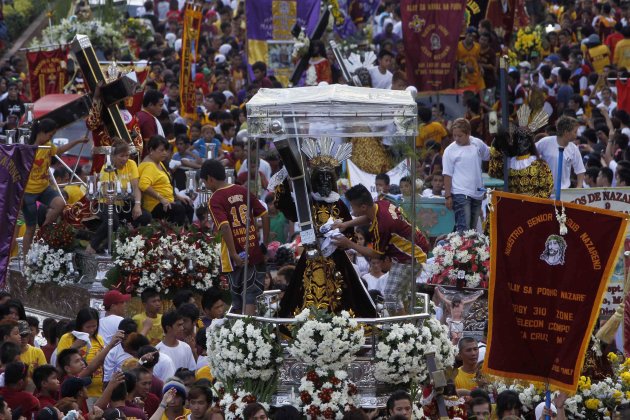
MANILA, Philippines --- Today, millions of devotees will once again endure and overcome long hours of risks and discomfort just to be able to take part in, perhaps, the longest religious procession in Philippine culture.
Putting at stake even their most precious lives, these flocks of faithful do not mind the ordeal in exchange for their commitment to take the centuries-old wooden image of the Black Nazarene from an overnight vigil at the Quirino Grandstand back to its humble abode at the Minor Basilica in Quiapo, Manila.
Lilibeth Bautista, 48, is among these devotees.
For her, people should never worry because God will make a way for them not to miss the feast day activities.
"The Black Nazarene has given us so many things," shared Bautista, citing that she will remain a devotee until her death.
Bautista attributed all her blessings in life, including the guidance that she and her son Michael Kenneth Arreza are getting, to her devotion to the Black Nazarene.
In 2003, then 13-year-old Michael was diagnosed with a benign tumor in his face.
"Since he was just a teenager then, his first question was 'why him'," said Bautista.
The tumor lasted until the following year, which made Bautista almost lose her hope. Little did she know that while she was praying, her feet brought her to the Quiapo Church. The next thing she knew, she became a Quiapo devotee.
"I didn't know how I got to the Minor Basilica but I just wished for a good doctor and that the Black Nazarene would guide us," said Bautista.
By 2011, Michael's tumor began to spread that he began to lose his sense of sight, hearing and even taste. He was almost lifeless for two minutes after a seizure, but his mother just prayed to the Black Nazarene to give his son more years to live.In what Bautista believed to be a miracle, Michael survived the seizure and underwent successful operation on November 27 last year.
Bautista expresses her devotion to the Black Nazarene by cooking food for some devotees who attend the overnight vigil. She also serves as Minister of Ushers at the Quiapo Church.
She doesn't mind going to the church even if she and her son come all the way from Cavite. Every year, she is also present in the procession. If possible, she would try to hold the rope attached to the image of the Black Nazarene for good luck.
This act of devotion is just normal, according to Bulacan priest Rev. Fr. Cirilo Palaca, DCD.
"They experience God's love and their prayers were answered through that show of devotion," said the priest, who serves at the popular Lourdes Shrine and Grotto in San Jose del Monte, in a phone interview.
Palaca also noted that some people might not really understand, but those devotees who come to the Quirino Grandstand and join the procession have "genuine" faith because the Lord answers their prayers.
"There are many people (in the vigil and in the procession) because many receive blessings from the Lord. They just manifest their devotion by joining the procession," he explained.For a plain spectator who might brand steadfast devotees' tear-jerking and breakdown behaviors as mere "fanaticism" and outright ridiculous, University of Santo Tomas Sociology professor Josephine Aguilar Placido said that it is all about expression of one's faith.
"You can never question how people express their emotions. Some people cry, some would kneel from the entrance (of the church) to the altar and for them, this is one way of expressing their faith and love to their Creator," she told the Manila Bulletin. "Now, we call this folk religiosity."
Both devotion and fanaticism, according to Placido, have their own purposes, though devotion is more inclined toward religion.
"Devotion is religion-oriented, but the term 'fanaticism' is sometimes used because you will see how people move... This is collective behavior," she said.
In the case of the Black Nazarene, people from all walks of life are affected, so they move with the same objective. They even come in groups or in clusters a purpose to achieve.
"Surprisingly, it is amazing to see young people doing that now," Placido observed. "Their belief in the Black Nazareno is based on the depth of their faith and on the custom passed onto them by their parents."
As for the devotees' strong belief that their devotion to the Black Nazarene would bring them good luck or good graces in their lives, Placido saw it as "one simple sociological imagination."
"This is one concept from a devotee and we have to respect that. Whatever purposes they have in mind and if that is their interpretation of what they are doing, then so be it," she said. (With an interview and report from Frederick Louis R. Castro II, MB Research intern, University of Santo Tomas)

Malaysia & Singapore & brunei ideal on-line blogshop for wholesale & quantity korean accessories, earrings, earstuds, locket, rings,
ReplyDeletebracelet, trinket & hair accessories. Promotion 35 % wholesale rebate. Ship Worldwide
Also visit my homepage ; locksmith salt lake city ut